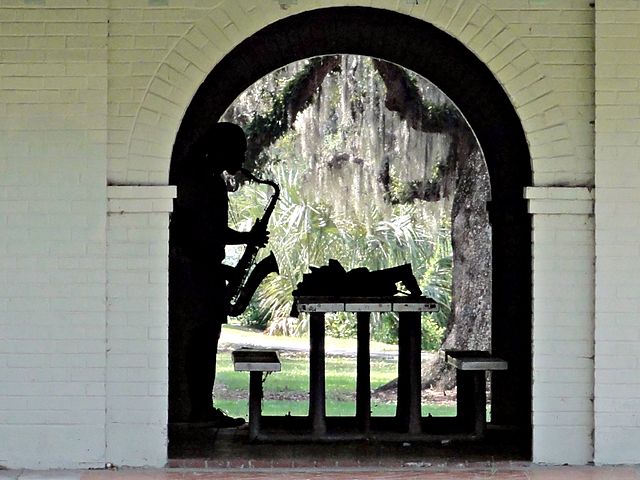UPDATE: We've summarized much of the series this article is part of in a new report, Policies for Shareable Cities: A Sharing Economy Policy Primer for Urban Leaders. Get your free copy here today.
Plazas, squares, parks, fields, playgrounds, open space, sports parks – these spaces are all critical to health, happiness, and community-building among city-dwellers. In addition to providing such spaces through a city's Parks and Recreation Department, city governments could adopt policies that incentivize the sharing of private spaces or that allow citizens to petition to create new public spaces.

The lush greenery of Scuffletown Park brightens up the Fan District of Richmond, Virginia. Photo credit: Taber Andrew Bain. Used under Creative Commons license.
Here are a few suggestions for ways that cities can adopt policies to promote such spaces:
-
Legalize fun in the front yard: Out of a desire to create a shared play space for neighborhood children, sometimes homeowners choose to put swing sets, play structures, basketball hoops, or other recreational equipment in their front yards. However, some city zoning laws prohibit using a front yard used in this way, and in Westport, Connecticut, a front-yard play structure has even turned into a major zoning dispute. Cities should change these laws and allow people to build certain kinds of play structures or swing sets in their front yard.
-
Create shareable intersections: Allow citizens to petition to block off and turn certain low-traffic intersections into public plazas. Intersection Repair, a project of City Repair in Portland, Oregon, has spearheaded such efforts toward “citizen-led conversion of urban street intersections into public squares.” Portland has even adopted an ordinance to allow for this.
-
Donate or lease city land to create more pocket parks and community gardens: Pocket parks are small or irregular vacant lots turned into small public green spaces. Many cities keep a list of what they call “surplus properties,” which tend to be small or irregularly shaped parcels of land that the city cannot really use. Why not turn those into mini parks or donate the land to a local land trust or community organization to turn it into green space? One inspiring project, called 596 Acres, has identified 596 acres of vacant publicly owned land in Brooklyn, New York, and is serving as a liaison between citizen groups and the city to encourage conversion of these lots to food-growing and recreational spaces.
-
Provide insurance to protect people that share recreational space: Recreational use statutes, which exist in every U.S. state, provide some level of liability protection to property owners that open up their properties for others to use for recreational purposes. For example, the owner of a vacant field might be protected from an injury lawsuit if she allows members of the public to come on to the property to play soccer. Cities can add to a property owner’s peace of mind by offering free or low-cost insurance to cover injuries that take place during public recreational use on private properties. The cost of insurance to the city would be much cheaper than the cost of providing and maintaining a comparable park.
-
Create shareable sidewalk strips: Allow citizens to petition to narrow their streets and widen sidewalk strips. If widened, the patch of land between a sidewalk and street (sometimes called “sidewalk strip” or “parking strip”) could serve as a social gathering space for neighbors, or could at least create a more satisfying dog-walking space. Narrowing streets and widening sidewalks generally enhances walkability of a street and encourages community and interaction among neighbors.
-
Depave: Many residences and businesses are required to have a minimum amount of paved area to serve as parking. Yet, there are so many good reasons to depave a space, including increasing percolation of rain water, reducing the urban heat island effect, and creating enjoyable pockets of nature for humans, bugs, birds, and others. Cities should be much more flexible with pavement requirements where property owners desire to create pockets of green space. Cities should also remove fees associated with the cutting and removal of pavement, as described by Richard Register in his discussion of depaving projects.
-
Allow for shareable walls: To encourage sharing and beautification of wall spaces, cities should lift bans on painting murals on private property. Many cities do not have a way to distinguish murals from billboards, and some put an outright ban on the painting of murals on private walls. Los Angeles, California, is now considering an ordinance revision that would legalize private murals and distinguish them from ads or billboards.
Stay tuned for more on related topics, as #10 and #11 in this series will discuss Shareable Rooftops and Community Gardening.
In the meantime, please tell us how else a city might encourage shareable recreational and green spaces? Please post your thoughts below and help us build this collection of policy proposals. Thank you!
This post is one of 15 parts of our Policies for a Shareable City series with the Sustainable Economies Law Center:
- Car Sharing and Parking Sharing
- Ride Sharing
- Bike Sharing
- Shareable Commercial Spaces
- Shareable Housing
- Homes as Sharing Hubs
- Shareable Neighborhoods
- Shareable Workspaces
- Recreational and Green Spaces
- Shareable Rooftops
- Urban Agriculture
- Food Sharing
- Public Libraries
- The Shareable City Employee
- How to Rebuild the City as a Platform









